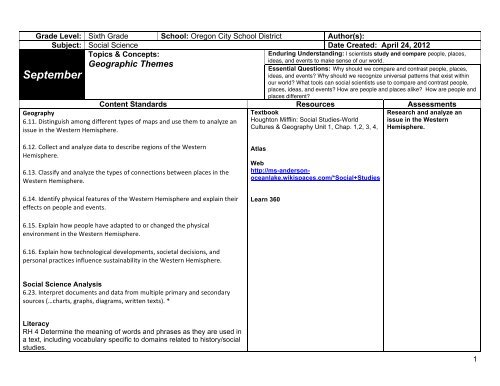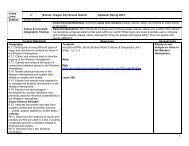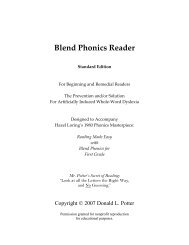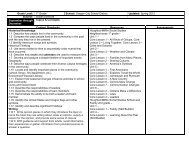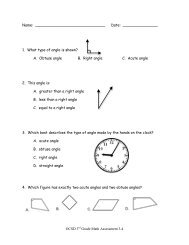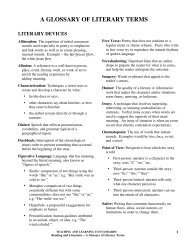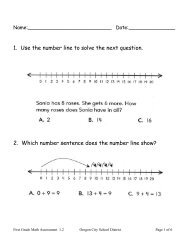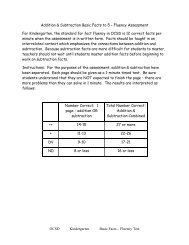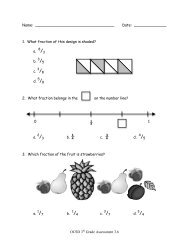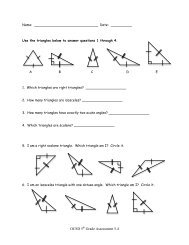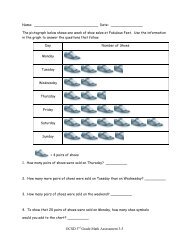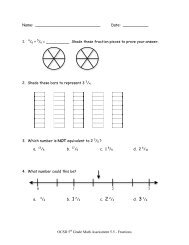Social Science Curriculum Map - Grade 6 - Oregon City School District
Social Science Curriculum Map - Grade 6 - Oregon City School District
Social Science Curriculum Map - Grade 6 - Oregon City School District
You also want an ePaper? Increase the reach of your titles
YUMPU automatically turns print PDFs into web optimized ePapers that Google loves.
<strong>Grade</strong> Level: Sixth <strong>Grade</strong> <strong>School</strong>: <strong>Oregon</strong> <strong>City</strong> <strong>School</strong> <strong>District</strong> Author(s):<br />
Subject: <strong>Social</strong> <strong>Science</strong> Date Created: April 24, 2012<br />
Topics & Concepts:<br />
Geographic Themes<br />
September<br />
Enduring Understanding: l scientists study and compare people, places,<br />
ideas, and events to make sense of our world.<br />
Essential Questions: Why should we compare and contrast people, places,<br />
ideas, and events Why should we recognize universal patterns that exist within<br />
our world What tools can social scientists use to compare and contrast people,<br />
places, ideas, and events How are people and places alike How are people and<br />
places different<br />
Content Standards Resources Assessments<br />
Geography <br />
6.11. Distinguish among different types of maps and use them to analyze an <br />
issue in the Western Hemisphere. <br />
Textbook<br />
Houghton Mifflin: <strong>Social</strong> Studies-World<br />
Cultures & Geography Unit 1, Chap. 1,2, 3, 4,<br />
Research and analyze an<br />
issue in the Western<br />
Hemisphere.<br />
6.12. Collect and analyze data to describe regions of the Western <br />
Hemisphere. <br />
6.13. Classify and analyze the types of connections between places in the <br />
Western Hemisphere. <br />
6.14. Identify physical features of the Western Hemisphere and explain their <br />
effects on people and events. <br />
Atlas<br />
Web<br />
http://ms-andersonoceanlake.wikispaces.com/*<strong>Social</strong>+Studies<br />
Learn 360<br />
6.15. Explain how people have adapted to or changed the physical <br />
environment in the Western Hemisphere. <br />
6.16. Explain how technological developments, societal decisions, and <br />
personal practices influence sustainability in the Western Hemisphere. <br />
<strong>Social</strong> <strong>Science</strong> Analysis<br />
6.23. Interpret documents and data from multiple primary and secondary <br />
sources (…charts, graphs, diagrams, written texts). * <br />
Literacy<br />
RH 4 Determine the meaning of words and phrases as they are used in<br />
a text, including vocabulary specific to domains related to history/social<br />
studies.<br />
1
RH 5 Describe how a text presents information<br />
RH 7 Integrate visual information<br />
Writing<br />
WH.4 Produce clear and coherent writing in which the development, <br />
organization, and style are appropriate to task, purpose, and <br />
audience. <br />
WH.5 <br />
WH.6 <br />
WH.10 <br />
With some guidance and support from peers and adults, <br />
develop and strengthen writing as needed by planning, <br />
revising, editing, rewriting, or trying a new approach, focusing <br />
on how well purpose and audience have been addressed.. <br />
Use technology, including the Internet, to produce and publish <br />
writing and present the relationships between information and <br />
ideas clearly and efficiently. <br />
Write routinely over extended time frames (time for reflection <br />
and revision) and shorter time frames (a single sitting or a day <br />
or two) for a range of discipline-‐specific tasks, purposes, and <br />
audiences. <br />
2
<strong>Grade</strong> Level: Sixth <strong>Grade</strong> <strong>School</strong>: <strong>Oregon</strong> <strong>City</strong> <strong>School</strong> <strong>District</strong> Author(s):<br />
Subject: <strong>Social</strong> <strong>Science</strong><br />
Date Created:<br />
Topics & Concepts: Cultures-Behind the Enduring Understanding:<br />
<strong>Social</strong> scientists recognize and analyze multiple points of view to explain the ideas and actions<br />
culture<br />
of individuals and groups.<br />
Aztec, Maya, Inca, Inuit<br />
October<br />
Essential Questions: How can differing points of view affect relations between and within<br />
societies Why should we recognize and analyze multiple points of view Why should we care<br />
about the perspectives of others<br />
Content Standards Resources ASSESSMENT<br />
Historical Knowledge <br />
6.1. Determine and explain the historical context of key people, <br />
cultures, products, events, and ideas over time including the <br />
examination of different perspectives from people involved including, <br />
but not limited to, Aztec, Maya, Inca, Inuit…* <br />
*This is PART of the Standard. <br />
Historical Thinking <br />
6.4. Explain how different cultures in the Western Hemisphere record <br />
history. <br />
6.7. Define and use the terms “decade,” “century,” and “millennium,” <br />
and compare alternative ways that historical periods and eras are <br />
designated by identifying the organizing principles upon which each is <br />
based. <br />
World Book Online<br />
Web<br />
Forms of Government<br />
http://www.mrsoshouse.com/puzpro/compcongovern<br />
.html<br />
http://ofcn.org/cyber.serv/academy/ace/soc/cec<br />
sst/cecsst088.html<br />
Mayan, Aztec, Inca, Inuit websites<br />
http://www.lessonpathways.com/Pathways/Detail/173<br />
76/the-mayans<br />
http://www.lessonpathways.com/Pathways/Detailpat<br />
h=%2f03_History%2fYear_5_History_Guided_Journe<br />
y%2f02Native_People_of_the_North<br />
Civics and Government <br />
6.17. Compare and contrast early forms of government via the study of <br />
early civilizations (tribal, monarchy, democracy, theocracy, and <br />
oligarchy) in the Western Hemisphere. <br />
<strong>Social</strong> <strong>Science</strong> Analysis <br />
6.23. Interpret documents and data from multiple primary and <br />
secondary sources (art, artifacts, …real or simulated historical sites…)*. <br />
*This is PART of the Standard. <br />
http://www.lessonpathways.com/Pathways/Detailpat<br />
h=%2fUser%3aLoliveras%2fNative_People_of_the_S<br />
outh%2fInca_Empire<br />
http://incas.mrdonn.org/index.html<br />
http://aztecs.mrdonn.org/index.html<br />
http://mayas.mrdonn.org/index.html<br />
http://ms-andersonoceanlake.wikispaces.com/*<strong>Social</strong>+Studies<br />
Literacy<br />
RH 4 Determine the meaning of words and phrases as they are used in <br />
a text, including vocabulary specific to domains related to <br />
3
history/social studies. <br />
RH 5 Describe how a text presents information <br />
RH 7 Intergrate visual information <br />
Writing<br />
WH.4 Produce clear and coherent writing in which the <br />
development, organization, and style are appropriate to <br />
task, purpose, and audience. <br />
WH.5 <br />
WH.6 <br />
WH.10 <br />
With some guidance and support from peers and <br />
adults, develop and strengthen writing as needed by <br />
planning, revising, editing, rewriting, or trying a new <br />
approach, focusing on how well purpose and audience <br />
have been addressed.. <br />
Use technology, including the Internet, to produce and <br />
publish writing and present the relationships between <br />
information and ideas clearly and efficiently. <br />
Write routinely over extended time frames (time for <br />
reflection and revision) and shorter time frames (a <br />
single sitting or a day or two) for a range of discipline-specific<br />
tasks, purposes, and audiences. <br />
4
<strong>Grade</strong> Level: Sixth <strong>Grade</strong> <strong>Oregon</strong> <strong>City</strong> <strong>School</strong> <strong>District</strong> Author(s):<br />
Subject: <strong>Social</strong> <strong>Science</strong><br />
Topics & Concepts: Major Explorers<br />
and Colonizers of Countries in Western<br />
Hemisphere, and the Columbian<br />
Exchange<br />
November<br />
Date Created:<br />
Enduring Understanding: <strong>Social</strong> scientists examine cause and effect to see relationships<br />
between people, places, ideas, and events.<br />
Essential Questions: Why are social scientists concerned about cause and effect<br />
How can examining cause and effect help us understand relationships between people, places,<br />
ideas, and events<br />
Content Standards Resources ASSESSMENT<br />
Historical Knowledge <br />
6.1. Determine and explain the historical context of key people, cultures, <br />
products, events, and ideas over time including the examination of <br />
different perspectives from people involved including, but not limited to, <br />
.., major explorers, colonizers of countries in the Western Hemisphere, <br />
and the Columbian Exchange. * <br />
*This is PART of the Standard. <br />
Historical Thinking <br />
6.8. Analyze cause-‐and-‐effect relationships, including the importance of <br />
individuals, ideas, human interests and beliefs. <br />
6.9. Differentiate between fact and interpretation in historical accounts <br />
and explain the meaning of historical passages by identifying who was <br />
involved, what happened, where it happened, and relating them to <br />
outcomes that followed and gaps in the historical record. <br />
<strong>Social</strong> <strong>Science</strong> Analysis <br />
6.23. Interpret documents and data from multiple primary and <br />
secondary sources (… eyewitness accounts, letters and diaries, …). <br />
*This is PART of the Standard. <br />
Literacy <br />
RH 1 Cite specific textual evidence to support analysis of primary and <br />
secondary sources. <br />
RH 3 Identify key steps in a text’s description of a process related to <br />
history/social studies. <br />
RH 4 Determine the meaning of words and phrases as they are used in a <br />
text, including vocabulary specific to domains related to history/social <br />
studies. <br />
RH 5 Describe how a text presents information <br />
RH 7 Integrate visual information <br />
Writing <br />
WH.2 Write informative/explanatory texts, including the narration <br />
of historical events, scientific procedures/ <br />
Textbook<br />
Houghton Mifflin: <strong>Social</strong> Studies-World Cultures &<br />
Geography pg. 310-313<br />
Web<br />
http://ms-andersonoceanlake.wikispaces.com/*<strong>Social</strong>+Studies<br />
Columbian Exchange<br />
http://msh.councilforeconed.org/lessons.phplid=68379<br />
Explorers<br />
http://jsdlib.jsd.k12.ca.us/Explorers.htm<br />
5
experiments, or technical processes. <br />
a. Introduce a topic clearly, previewing what is to <br />
follow; organize ideas, concepts, and <br />
information into broader categories as <br />
appropriate to achieving purpose; include <br />
formatting (e.g., headings), graphics (e.g., charts, <br />
tables), and multimedia when useful to aiding <br />
comprehension. <br />
b. Develop the topic with relevant, well-‐chosen <br />
facts, definitions, concrete details, quotations, <br />
or other information and examples. <br />
c. Use appropriate and varied transitions to create <br />
cohesion and clarify the relationships among <br />
ideas and concepts. <br />
d. Use precise language and domain-‐specific <br />
vocabulary to inform about or explain the topic. <br />
e. Establish and maintain a formal style and <br />
objective tone. <br />
f. Provide a concluding statement or section that <br />
follows from and supports the information or <br />
explanation presented. <br />
WH.4 Produce clear and coherent writing in which the development, <br />
organization, and style are appropriate to task, purpose, <br />
and audience. <br />
WH.5 <br />
WH.6 <br />
With some guidance and support from peers and adults, <br />
develop and strengthen writing as needed by planning, <br />
revising, editing, rewriting, or trying a new approach, <br />
focusing on how well purpose and audience have been <br />
addressed.. <br />
Use technology, including the Internet, to produce and <br />
publish writing and present the relationships between <br />
information and ideas clearly and efficiently. <br />
6
WH.10 <br />
Write routinely over extended time frames (time for <br />
reflection and revision) and shorter time frames (a single <br />
sitting or a day or two) for a range of discipline-‐specific <br />
tasks, purposes, and audiences. <br />
7
<strong>Grade</strong> Level: Sixth <strong>Grade</strong> <strong>School</strong>: <strong>Oregon</strong> <strong>City</strong> <strong>School</strong> <strong>District</strong> Author(s):<br />
Subject: <strong>Social</strong> <strong>Science</strong><br />
Date Created:<br />
Topics & Concepts: Major Explorers and<br />
Enduring Understanding:<br />
Colonizers of Countries in Western<br />
Hemisphere and Columbian Exchange<br />
Essential Questions:<br />
December<br />
Content Standards Resources Assessments<br />
Continuation of November Standards <br />
8
<strong>Grade</strong> Level: Sixth <strong>Grade</strong> <strong>School</strong>: <strong>Oregon</strong> <strong>City</strong> <strong>School</strong> <strong>District</strong> Author(s):<br />
Subject: <strong>Social</strong> <strong>Science</strong><br />
Topics & Concepts: Rise and Fall of<br />
Ancient Civilizations in Europe,<br />
Asia and Africa<br />
January<br />
Date Created:<br />
Enduring Understanding: <strong>Social</strong> scientists analyze and recognize how people,<br />
places, and ideas change over time.<br />
Essential Questions: How can people, places, and ideas change over time<br />
How have the actions, ideas, and values of people changed over time How can the study<br />
of history helps us connect continuity and change<br />
Content Standards Resources ASSESSMENT<br />
Historical Knowledge <br />
6.3. Describe the rise; the political, technological, and cultural <br />
achievements; and the decline of ancient civilizations in Europe, <br />
Asia, and Africa prior to the Roman Empire. <br />
Historical Thinking <br />
6.5. Critique information to determine if it is sufficient to answer <br />
historical questions. <br />
Literacy <br />
RH 4 Determine the meaning of words and phrases as they are <br />
used in a text, including vocabulary specific to domains related to <br />
history/social studies. <br />
RH 5 Describe how a text presents information <br />
RH 7 Integrate visual information <br />
Writing <br />
WH.4 Produce clear and coherent writing in which the <br />
development, organization, and style are <br />
appropriate to task, purpose, and audience. <br />
WH.5 <br />
WH.6 <br />
WH.10 <br />
With some guidance and support from peers and <br />
adults, develop and strengthen writing as needed <br />
by planning, revising, editing, rewriting, or trying a <br />
new approach, focusing on how well purpose and <br />
audience have been addressed.. <br />
Use technology, including the Internet, to produce <br />
and publish writing and present the relationships <br />
between information and ideas clearly and <br />
efficiently. <br />
Write routinely over extended time frames (time <br />
Textbook:<br />
Houghton Mifflin: <strong>Social</strong> Studies-World Cultures &<br />
Geography: Chapter 15, unit 6, pg 292-297<br />
Glencoe<br />
World History: Journey Across Time (7 th grade) pg.<br />
pg.8-15, pg. 17-23, pg. 26-30, pg. 38-67, pg. 444-476<br />
http://medievaleurope.mrdonn.org/lessonplans<br />
.html<br />
http://www.studenthandouts.com/World_Histor<br />
y/Units/09.04/01.Outlines-PowerPoints.htm<br />
http://edsitement.neh.gov/lesson-plan/noteveryone-lived-castles-during-middle-ages<br />
-<br />
sect-questions<br />
http://china.mrdonn.org/lessonplans.html<br />
http://www.nationalarchives.gov.uk/documents<br />
/education/medieval-cartoon.pdf<br />
http://www.studenthandouts.com/World_Histor<br />
y/worldhistory09section16.htm<br />
http://africa.mrdonn.org/lessonplans.html<br />
9
for reflection and revision) and shorter time frames <br />
(a single sitting or a day or two) for a range of <br />
discipline-‐specific tasks, purposes, and audiences. <br />
10
<strong>Grade</strong> Level: Sixth <strong>Grade</strong> <strong>School</strong>: <strong>Oregon</strong> <strong>City</strong> <strong>School</strong> <strong>District</strong> Author(s):<br />
Subject: <strong>Social</strong> <strong>Science</strong><br />
Date Created:<br />
Topics & Concepts: Rise and Fall of<br />
Enduring Understanding:<br />
Ancient Civilizations in Europe, Asia<br />
and Africa<br />
Essential Questions:<br />
February<br />
Content Standards Resources Assessments<br />
Continuation of February Standards <br />
11
<strong>Grade</strong> Level: Sixth <strong>Grade</strong> <strong>School</strong>: <strong>Oregon</strong> <strong>City</strong> <strong>School</strong> <strong>District</strong> Author(s):<br />
Subject: <strong>Social</strong> <strong>Science</strong><br />
Topics & Concepts: Native<br />
American<br />
March<br />
Date Created:<br />
Enduring Understanding: <strong>Social</strong> scientists recognize and analyze multiple points of view to<br />
explain the ideas and actions of individuals and groups.<br />
Essential Questions: Why should we recognize and analyze multiple points of view<br />
Why should we care about the perspectives of others<br />
Content Standards Resources Assessments<br />
Historical Knowledge <br />
6.1. Determine and explain the historical context of key people, <br />
cultures, products, events, and ideas over time including the <br />
examination of different perspectives from people involved <br />
including, but not limited to, early Native American cultures of <br />
North America. <br />
*This is PART of the Standard. <br />
6.6. Create and compare timelines that identify major people, <br />
events and developments in the history of individual civilizations <br />
and/or countries that comprise the Americas <br />
http://www.academicamerican.com/coloni<br />
al/topics/nativeam.htm<br />
http://www.pbs.org/teachers/connect/reso<br />
urces/2812/preview/<br />
http://www.pbs.org/teachers/connect/reso<br />
urces/7021/preview/<br />
Literacy <br />
RH 1 Cite specific textual evidence to support analysis of primary <br />
and secondary sources. <br />
RH 3 Identify key steps in a text’s description of a process related <br />
to history/social studies. <br />
RH 4 Determine the meaning of words and phrases as they are <br />
used in a text, including vocabulary specific to domains related to <br />
history/social studies. <br />
RH 5 Describe how a text presents information <br />
RH 7 Integrate visual information <br />
RH.8 Distinguish among fact, opinion, and reasoned judgment in <br />
a text. <br />
RH.9 Analyze the relationship between a primary and secondary <br />
source on the same topic. <br />
RH.10 By the end of grade 8, read and comprehend history/social <br />
studies texts in the grades 6–8 text complexity band independently <br />
and proficiently. <br />
Writing <br />
WH.2 Write informative/explanatory texts, including the <br />
http://www.lessonpathways.com/Pathway<br />
s/Detailpath=%2f03_History%2fYear_5_<br />
History_Guided_Journey%2f02Native_Pe<br />
ople_of_the_North<br />
http://exploringafrica.matrix.msu.edu/teac<br />
hers/curriculum/m7b/activity1.php<br />
Web<br />
http://ms-andersonoceanlake.wikispaces.com/*<strong>Social</strong>+Studies<br />
http://www.teachervision.fen.com/nativeamerican-heritage-month/teacherresources/6648.html<br />
12
narration of historical events, scientific procedures/ <br />
experiments, or technical processes. <br />
g. Introduce a topic clearly, previewing what <br />
is to follow; organize ideas, concepts, and <br />
information into broader categories as <br />
appropriate to achieving purpose; include <br />
formatting (e.g., headings), graphics (e.g., <br />
charts, tables), and multimedia when <br />
useful to aiding comprehension. <br />
h. Develop the topic with relevant, well-chosen<br />
facts, definitions, concrete details, <br />
quotations, or other information and <br />
examples. <br />
i. Use appropriate and varied transitions to <br />
create cohesion and clarify the <br />
relationships among ideas and concepts. <br />
j. Use precise language and domain-‐specific <br />
vocabulary to inform about or explain the <br />
topic. <br />
k. Establish and maintain a formal style and <br />
objective tone. <br />
l. Provide a concluding statement or section <br />
that follows from and supports the <br />
information or explanation presented <br />
WH.4 Produce clear and coherent writing in which the <br />
development, organization, and style are <br />
appropriate to task, purpose, and audience. <br />
WH.5 <br />
WH.6 <br />
With some guidance and support from peers and <br />
adults, develop and strengthen writing as needed <br />
by planning, revising, editing, rewriting, or trying a <br />
new approach, focusing on how well purpose and <br />
audience have been addressed.. <br />
Use technology, including the Internet, to produce <br />
13
WH.10 <br />
and publish writing and present the relationships <br />
between information and ideas clearly and <br />
efficiently. <br />
Write routinely over extended time frames (time <br />
for reflection and revision) and shorter time frames <br />
(a single sitting or a day or two) for a range of <br />
discipline-‐specific tasks, purposes, and audiences. <br />
14
<strong>Grade</strong> Level: Sixth <strong>Grade</strong> <strong>School</strong>: <strong>Oregon</strong> <strong>City</strong> <strong>School</strong> <strong>District</strong> Author(s):<br />
Subject: <strong>Social</strong> <strong>Science</strong><br />
Date Created:<br />
Topics & Concepts: Native America<br />
Enduring Understanding:<br />
April<br />
Essential Questions:<br />
Content Standards Resources Assessments<br />
Continuation of February Standards <br />
15
<strong>Grade</strong> Level: Sixth <strong>Grade</strong> <strong>School</strong>: <strong>Oregon</strong> <strong>City</strong> <strong>School</strong> <strong>District</strong> Author(s):<br />
Subject: <strong>Social</strong> <strong>Science</strong><br />
Topics & Concepts: In depth study of a<br />
Western Hemisphere issue of a<br />
historical event<br />
May<br />
Date Created:<br />
Enduring Understanding: <strong>Social</strong> scientists find the connections between<br />
events of the past and present to help understand our world.<br />
Essential Questions: How can studying the past help us understand the<br />
present world and the future<br />
How can the study of history help us compare and contrast the relationship<br />
between the past and present<br />
Content Standards Resources Assessments<br />
Historical Knowledge<br />
6.2. Identify examples of the social, political, cultural, and economic development in <br />
key areas of the Western Hemisphere <br />
6.10. Identify issues related to a historical event in the Americas and give basic <br />
arguments for and against that issue utilizing the perspectives, interests and values <br />
of those involved. <br />
http://www.besthistorysites.net/<br />
<strong>Social</strong> <strong>Science</strong> Analysis <br />
6.20. Critique information to determine if it is sufficient to answer questions. <br />
6.21. Clarify key aspects of an event, issue, or problem through inquiry and <br />
research. <br />
6.22. Gather, interpret, document, and use information from multiple sources, <br />
distinguishing facts from opinions and recognizing points of view. <br />
Literacy <br />
RH 1 Cite specific textual evidence to support analysis of primary and secondary <br />
sources. <br />
RH 3 Identify key steps in a text’s description of a process related to history/social <br />
studies. <br />
RH 4 Determine the meaning of words and phrases as they are used in a text, <br />
including vocabulary specific to domains related to history/social studies. <br />
RH 5 Describe how a text presents information <br />
RH 7 Integrate visual information <br />
RH.9 Analyze the relationship between a primary and secondary source on the <br />
same topic. <br />
16
Writing <br />
WH.4 Produce clear and coherent writing in which the development, <br />
organization, and style are appropriate to task, purpose, and <br />
audience. <br />
WH.5 <br />
WH.6 <br />
WH.7 <br />
WH.8 <br />
WH.9 <br />
WH.10 <br />
With some guidance and support from peers and adults, develop <br />
and strengthen writing as needed by planning, revising, editing, <br />
rewriting, or trying a new approach, focusing on how well purpose <br />
and audience have been addressed.. <br />
Use technology, including the Internet, to produce and publish <br />
writing and present the relationships between information and ideas <br />
clearly and efficiently. <br />
Conduct short research projects to answer a question (including a <br />
self-‐generated question), drawing on several sources and <br />
generating additional related, focused questions that allow for <br />
multiple avenues of exploration. <br />
Gather relevant information from multiple print and digital <br />
sources, using search terms effectively; assess the credibility and <br />
accuracy of each source; and quote or paraphrase the data and <br />
conclusions of others while avoiding plagiarism and following a <br />
standard format for citation. <br />
Draw evidence from informational texts to support analysis, <br />
reflection, and research. <br />
Write routinely over extended time frames (time for reflection and <br />
revision) and shorter time frames (a single sitting or a day or two) for <br />
a range of discipline-‐specific tasks, purposes, and audiences. <br />
17
<strong>Grade</strong> Level: Sixth <strong>Grade</strong> <strong>School</strong>: <strong>Oregon</strong> <strong>City</strong> <strong>School</strong> <strong>District</strong> Author(s):<br />
Subject: <strong>Social</strong> <strong>Science</strong><br />
Date Created:<br />
Topics & Concepts: Current forms of<br />
Enduring Understanding:<br />
government and economics in the<br />
Western Hemisphere<br />
Essential Questions:<br />
June<br />
Content Standards Resources Assessments<br />
Civics and Government<br />
6.18. Describe current forms of government in countries in the Western Hemisphere. <br />
Economics/Financial Literacy <br />
6.19. Describe the role and function of prices in the economy. <br />
Literacy <br />
RH 1 Cite specific textual evidence to support analysis of primary and secondary <br />
sources. <br />
RH 3 Identify key steps in a text’s description of a process related to history/social <br />
studies. <br />
RH 4 Determine the meaning of words and phrases as they are used in a text, <br />
including vocabulary specific to domains related to history/social studies. <br />
RH 5 Describe how a text presents information <br />
RH 7 Integrate visual information <br />
Writing <br />
WH.4 Produce clear and coherent writing in which the development, organization, <br />
and style are appropriate to task, purpose, and audience. <br />
WH.5 <br />
WH.6 <br />
WH.10 <br />
With some guidance and support from peers and adults, develop and <br />
strengthen writing as needed by planning, revising, editing, rewriting, <br />
or trying a new approach, focusing on how well purpose and audience <br />
have been addressed.. <br />
Use technology, including the Internet, to produce and publish writing <br />
and present the relationships between information and ideas clearly <br />
and efficiently. <br />
Write routinely over extended time frames (time for reflection and <br />
revision) and shorter time frames (a single sitting or a day or two) for a <br />
range of discipline-‐specific tasks, purposes, and audiences. <br />
NOTE: WH.3 is not addressed in the social Studies/literacy standard <br />
18


